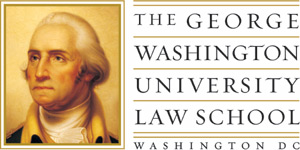
Stanford Law School (SLS) is the law school of Stanford University, a private research university near Palo Alto, California. Established in 1893, it has regularly ranked among the top three law schools in the United States by U.S. News & World Report since the magazine first published law school rankings in the 1980s and has ranked second for most of the past decade. In 2021, Stanford Law had an acceptance rate of 6.28%, the second-lowest of any law school in the country. Since 2019, Jennifer Martínez has served as its dean.
Boston College Law School is the law school of Boston College. It is situated on a 40-acre (160,000 m2) wooded campus in Newton, Massachusetts, about 1.5 miles from the university's main campus in Chestnut Hill, Massachusetts.

The Georgetown University Law Center is the law school of Georgetown University, a private research university in Washington, D.C. It was established in 1870 and is the largest law school in the United States by enrollment and the most applied to, receiving more full-time applications than any other law school in the country.

The George Washington University Law School is the law school of George Washington University, in Washington, D.C. Established in 1865, GW Law is the oldest top law school in the national capital. GW Law offers the largest range of courses in the US, with 275 elective courses in business and finance law, environmental law, government procurement law, intellectual property law, international comparative law, litigation and dispute resolution, and national security and U.S. foreign relations law. Admissions are highly selective as the law school receives thousands of applications. In 2020, the acceptance rate was 21%.

The University of New Hampshire Franklin Pierce School of Law is a public law school in Concord, New Hampshire, associated with the University of New Hampshire. It is the only law school in the state and was founded in 1973 by Robert H. Rines as the Franklin Pierce Law Center, named after the 14th President of the United States and New Hampshire native. The school is particularly well known for its Intellectual Property Law program.

The Harvard Journal of Law & Technology is a biannual open access law journal, established at Harvard Law School in 1988. It covers all aspects of technology law, including constitutional issues, intellectual property, biotechnology, privacy law, computer law, cybercrime, antitrust, space law, telecommunications, the Internet, and e-commerce. According to the Washington and Lee Law Journal Ranking, it is the most cited technology law journal and the highest ranked specialized law journal in the United States. Its online component, the JOLT Digest, issues short synopses of recent developments in all areas of law and technology.

Rajiv Gandhi School of Intellectual Property Law, IIT Kharagpur is a law school located in Kharagpur, West Bengal, India. An academic unit of Indian Institute of Technology Kharagpur, it is the first law school to be established in an Indian Institute of Technology (IIT). It was set up in collaboration with the George Washington University Law School, Washington DC and is the only law school within the IIT system. It is also the first law school in India imparting full-time Intellectual Property education along with other regular courses prescribed by the Bar Council of India.
The Yale Journal of Law & Technology (YJoLT), formerly Yale Symposium on Law & Technology, is a law review of Yale Law School.

The Fordham Intellectual Property, Media & Entertainment Law Journal is a specialty law journal of Fordham University School of Law that publishes articles on topics in patent, trademark, copyright, First Amendment, and media law. According to the 2019 Washington & Lee journal and law review rankings, it is ranked number one in the US for intellectual property law, number two in communications and media law, number three for arts, entertainment, and sports law, and was the most cited US law journal devoted to intellectual property law. The Fordham IPLJ articles have been read into the Congressional Record, cited in the Court of Appeals for the Second Circuit, and in amicus briefs to the U.S. Supreme Court.

Fordham University School of Law is the law school of Fordham University. The school is located in Manhattan in New York City, and is one of eight ABA-approved law schools in that city. In 2013, 91% of the law school's first-time test takers passed the bar exam, placing the law schools' graduates as fifth-best at passing the New York bar exam among New York's 15 law schools.

The Berkeley Technology Law Journal (BTLJ) is a law journal published at the University of California, Berkeley School of Law. It started publication in Spring 1986 as the High Technology Law Journal and changed its name to BTLJ in 1996. The journal covers emerging issues of law in the areas of intellectual property, cyber law, information law, and biotechnology, as well as antitrust and telecommunications law. The journal appears quarterly and its membership typically includes over 100 students. The Journal was ranked 45 among 1605 law journals in the Washington and Lee University School of Law's journal ranking list.
The Journal of High Technology Law is one of five law journals at Suffolk University Law School publishing articles, blogs, and book reviews covering subjects related to technology law. It was established in 1998 and became Suffolk's fourth honor board law journal in 2001. In Washington and Lee University's 2017 rankings of law journals with the highest impact factor, the journal was ranked 7th among law journals specializing in Science, Technology and Computing, 8th among law journals specializing in Intellectual Property, and was ranked 148th among all 1,549 United States law journals.

University of Akron School of Law is the law school at the University of Akron in Akron, Ohio. Offering both Juris Doctor and Master of Laws degrees, it was founded in 1921 as the Akron School of Law and merged with the University of Akron in 1959, becoming fully accredited by the American Bar Association in 1961. Since 1921, the school has produced over 6,000 graduates who have gone on to careers in the private and public sectors, including several notable judges and politicians. Located across from E. J. Thomas Hall on University Avenue, the University of Akron School of Law is housed in the C. Blake McDowell Law Center on the northwest portion of the University of Akron campus. It also houses the Joseph G. Miller and William C. Becker Institute for Professional Responsibility and The University of Akron Center for Constitutional Law, one of only four constitutional law centers established by Congress in the United States.
The Virginia Journal of Law and Technology (VJOLT) is a quarterly law review edited and published by students at the University of Virginia School of Law. It is indexed by Westlaw, LexisNexis and Bloomberg Law. The journal was ranked 18th among 59 Science, Technology, and Computing law journals in the Washington and Lee University School of Law's 2016 journal ranking list. VJOLT was established in 1996 and covers topics including intellectual property, biotechnology, digital privacy, antitrust and telecommunications law. In addition, the journal co-sponsors an annual symposium on an emerging area of technology and law each spring.
Journal of Intellectual Property Law is a biannual student-edited law review covering intellectual property law published by the University of Georgia School of Law. The journal covers trademarks, patents, copyright law, trade secrets, internet law, and sports and entertainment law.
The Stanford Environmental Law Journal is a student-run law review published at Stanford Law School that covers natural resources law, environmental policy, law and economics, international environmental law, and other related disciplines.
The Minnesota Journal of Law, Science & Technology is a biannual law review edited by students and faculty from the University of Minnesota. It was established in 2000 as the Minnesota Intellectual Property Review and covers issues in patents, trademarks, copyrights, bioethics, science, and technology as it relates to the law. Claire Colby is the editor-in-chief of Volume 24.
The Columbia Journal of Law & the Arts (JLA) is a quarterly, student-edited law review published at Columbia Law School. The Journal publishes articles and notes dedicated to in-depth coverage of current legal issues in the art, entertainment, sports, intellectual property, and communications industries. It features contributions by scholars, judges, practitioners, and students.

The Michigan State Law Review is a law review published by students at Michigan State University College of Law. It is the flagship journal of the school and it publishes five issues per year. According to the Washington & Lee Law Journal Ranking, Michigan State Law Review was the 48th highest-ranked flagship legal journal in 2022, a dramatic increase from its ranking of 332rd in 2003. The journal hosts an annual academic conference of global legal experts with past events covering issues such as autonomous vehicles, quantitative legal analysis, civil rights, and intellectual property. Professor David Blankfein-Tabachnick has served as Faculty Advisor of the journal since his appointment in 2016. In 2018, the journal began publishing an annual "Visionary Article Series," which features the work of one prominent legal scholar per year.










